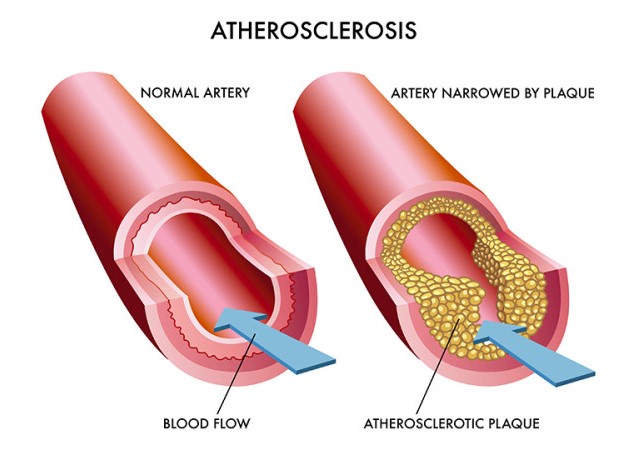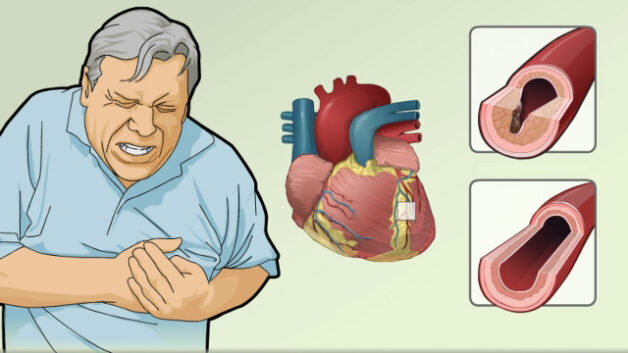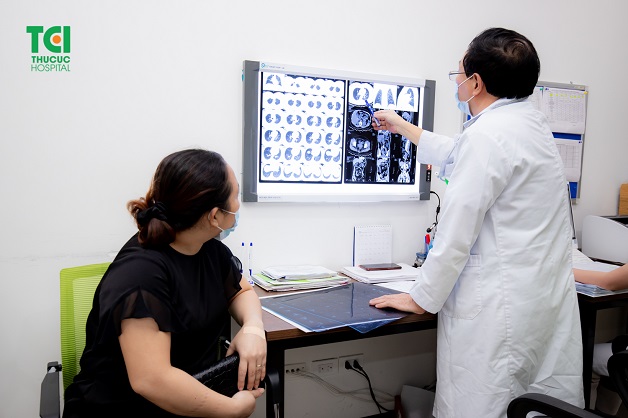Atherosclerosis is an increasingly common condition and a significant cause of cardiovascular diseases and other organ-related complications. Let’s explore the symptoms of atherosclerosis and the consequences of this condition.
1. Atherosclerosis and its Consequences
Atherosclerosis involves the accumulation of fatty deposits and other substances within the arteries, forming plaques. These plaques can impede blood flow, making it difficult for blood to circulate to various organs in the body, resulting in unforeseen consequences.

Artery with plaque buil-up
The main arteries in the body include coronary arteries, carotid arteries, and peripheral arteries. Depending on the location and development of atherosclerotic plaques, the disease can lead to different consequences:
– Coronary artery disease (CAD): These arteries supply oxygen-rich blood to the heart. Plaques in these arteries can cause angina (chest pain) and myocardial infarction (heart attack).
– Carotid artery disease: These arteries supply oxygen to the brain. Narrowing of these arteries due to atherosclerotic plaques can lead to reduced blood flow, increasing the risk of stroke and permanent brain damage.
– Peripheral arterial disease (PAD): The presence of plaques can obstruct blood flow to limbs, causing symptoms such as muscle atrophy, dryness in the affected areas, continuous pain, and reduced pain relief during rest.
2. Symptoms
2.1 Symptoms of Coronary Artery Disease
Coronary arteries are often affected by atherosclerosis, resulting in inadequate blood supply to the heart. Common symptoms include chest pain, with stable angina (pain during exertion relieved by rest or medication) and unstable angina (pain persisting at rest or not relieved by medication) being prevalent. Severe and recurrent chest pain lasting over 15 minutes should raise concerns about acute myocardial infarction.
Additionally, patients may experience difficulty breathing, rapid heartbeat, palpitations, and a pounding sensation in the chest.

Angina is a typical symptom of coronary artery disease.
2.2 Symptoms of Carotid Artery Disease
Plaques in carotid arteries can affect the circulatory system in the brain, leading to symptoms such as:
– Significant memory and cognitive decline
– Headaches and dizziness
– Hemiplegia (paralysis on one side of the body)
These symptoms are often challenging to detect early. In many cases, atherosclerosis becomes severe before symptoms manifest, leading to a higher risk of stroke and irreversible brain damage.
2.3 Symptoms of Peripheral Arterial Disease
Impaired blood flow to the limbs can cause various discomforts, including:
– Muscle atrophy
– Dryness in affected limbs
– Continuous pain and fatigue, even with light physical activity
– Pain relief upon rest
These symptoms significantly impact the patient’s daily activities.
If any of the above signs are observed, it is crucial for patients to seek prompt medical attention to accurately determine the location of atherosclerosis plaques and initiate appropriate treatment protocols.
3. Risk Factors for Atherosclerotic Plaque Formation
Arterial atherosclerosis can affect anyone but is more common in specific populations. Risk factors contributing to the formation of atherosclerotic plaques include:
3.1 Lipid Disorders
Elevated blood cholesterol levels, particularly low-density lipoprotein (LDL) cholesterol, play a crucial role in atherosclerotic plaque formation. Increased LDL cholesterol levels raise the risk of arterial plaque development.
3.2 Hypertension
High blood pressure is a significant risk factor for arterial atherosclerosis. Elevated blood pressure thickens arterial walls, reducing elasticity and increasing the likelihood of plaque formation.
3.3 Diabetes Mellitus
Consistently high blood sugar levels can damage blood vessels, increasing the risk of atherosclerosis. Diabetes is also associated with lipid disorders, contributing to plaque formation.
3.4 Smoking
Smoking is a major contributor to high blood pressure and is strongly associated with an increased risk of coronary artery disease. Studies show that smokers are twice as likely to develop coronary artery disease compared to non-smokers, particularly those who smoke heavily.
3.5 Obesity and Sedentary Lifestyle
Physical inactivity and a diet high in fat contribute to elevated LDL cholesterol levels and obesity, increasing the risk of developing atherosclerotic plaques.
Other factors such as stress and uncontrolled use of hormonal contraceptives can also contribute to a higher risk of atherosclerosis.

Regular cardiovascular check-ups are essential for early detection and effective management of atherosclerosis
In conclusion, arterial atherosclerosis often remains asymptomatic in its early stages, with symptoms becoming apparent only when plaques have significantly obstructed blood flow. Regular cardiovascular check-ups are essential for early detection and effective management of this condition. If any suspicious symptoms arise, prompt medical evaluation is crucial for accurate diagnosis and timely intervention.








